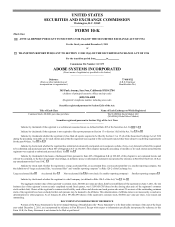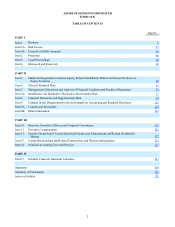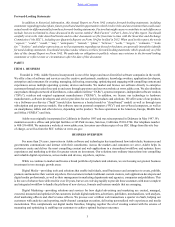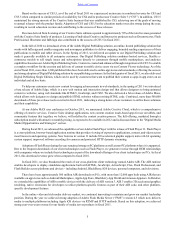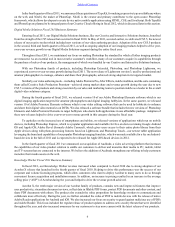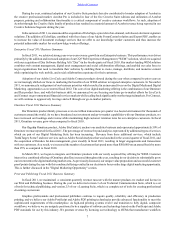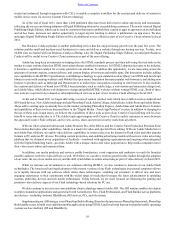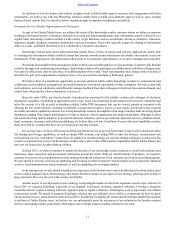Adobe 2011 Annual Report Download - page 8
Download and view the complete annual report
Please find page 8 of the 2011 Adobe annual report below. You can navigate through the pages in the report by either clicking on the pages listed below, or by using the keyword search tool below to find specific information within the annual report.
8
software, printers and other output devices, and in fiscal 2011, we maintained our OEM PostScript revenue through continued
innovation with PostScript technologies.
Fiscal 2012 Business Segment Market Opportunities and Strategies
Digital Media Segment
Digital Media Market Opportunities and Strategies
We believe we are at a key inflection point in the history of the internet. Convergence of major trends is occurring which
is driving changes in consumer behavior and expectations. These trends include the rise in use of smartphones and tablets, increased
internet access speeds, new business models driven by online commerce and app stores, the increase in media and entertainment
made available online, the impact of social online communication, and software delivery transitioning from prior PC delivery
models to cloud-based services.
These trends and changes are having a profound impact on our customers. Adobe customers—large and small—are
rethinking its online presence, addressing concerns such as how to make its site more dynamic, how to manage visitors from both
PC and non-PC devices, whether to invest in web browser-based applications or create individual mobile apps, and how to transition
from legacy content delivery methods to new models which present new revenue streams. For our customers, these challenges
create a great deal of complexity in their workflows and cost structures. For Adobe, these challenges and the complexity our
customers face are growing the size of the markets we can target.
In fiscal 2012 with our newly named Digital Media business, we believe these market conditions present significant
opportunities for Adobe to rapidly deliver product innovation, access new market segments, increase engagement with our
customers, transition our business to more of a recurring revenue model, and accelerate our revenue growth. Our goal is to be the
leading provider of tools and services that allow individuals, small businesses and enterprises to create, publish, promote and
monetize their content anywhere.
The flagship of our Digital Media business is our Creative Suite family of products. Consisting of thirteen individual
products and five suites that contain different configurations of these products, we focus on the needs of creative professional
customers, which include graphic designers, production artists, web designers and developers, user interface designers, writers,
videographers, motion graphic artists, prepress professionals, video game developers, mobile application developers, students and
administrators. They use and rely on our solutions for publishing, web design and development, video and animation production,
mobile app and gaming development and, document creation and collaboration. They work in businesses ranging from large
publishers, media companies and global enterprises, to smaller design agencies, small and medium-sized businesses, and individual
freelancers.
Our Creative Suite family of products is used by creative professionals to create much of the printed and on-line information
people see, read and interact with every day, including newspapers, magazines, websites, mobile apps, catalogs, advertisements,
brochures, product documentation, books, memos, reports and banners. Our tools are also used to create and enhance visually rich
content, including video, animation and mobile content, that is created by multimedia, film, television, audio and video producers
who work in advertising, web design, music, entertainment, corporate and marketing communications, product design, user
interface design, sales training, printing, architecture and fine arts. Knowledge workers, educators, hobbyists and high end
consumers also use our creative products to create and deliver content that is of creative professional quality.
We believe the innovation we deliver in the tools and solutions our customers use enables the future of digital media. Our
creative solutions are mission-critical to customers such as publishers, advertisers and media companies; they rely on Adobe tools
and technologies to create highly compelling content, deliver it across diverse media and devices, and then optimize it through
systematic targeting and measurement. For example:
• Publishers around the world are striving to embrace the digital age to build distinctive brands, develop sustainable
business strategies, achieve greater profitability, and deliver optimized content to fragmented audiences on an expanding
array of smartphones, tablets, e-readers, and other devices. Their audiences seek compelling, media-rich experiences,
wherever they go, using their preferred devices.
• Advertisers face an ever-shifting media landscape. Traditional media are giving way to the emergence of new digital
channels such as mobile devices and social networks. Customers have greater choice in where they go for their preferred
brands, making it harder to keep audiences engaged. Successful advertising increasingly requires compelling content
and greater focus on data and analytics than ever before in order to optimize advertising for improved targeting and
higher returns.
Table of Contents

